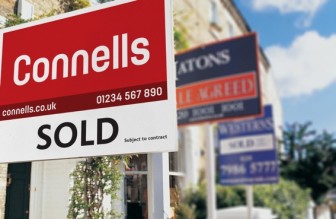One in every 50 homes listed for sale between 1 January and 15 April was sold, up from one in every 100 homes during the corresponding period last year, the latest research by Zoopla shows.
Running six weeks ahead of a typical year, this level of sales would not normally be achieved until the end of June, according to the property portal.
The latest findings from Zoopla in its monthly House Price Index reveal that the UK housing market has recorded £149bn worth of property sales in the first 15 weeks of this year, equating to almost double the value of homes sold in the same period in 2020 and 2019.
Acute market activity is eroding the volume of homes for sale, with the total number of homes available to buy, and not yet under offer, down almost 30% in the first half of April compared to average levels in the same period during 2017-19.
Glasgow, Bristol, Nottingham, Stoke, and Middlesbrough are the top five busiest sales markets in the UK.
House price growth tracked at 4% in March of this year, down from 4.5% recorded in January of this year.
While this indicates a slight softening in pace of growth – and the slowest rate of growth since October – residential property prices remain almost double the 2.1% growth recorded in March 2020, upheld by lack of supply coming to market.
Meanwhile, Manchester, Liverpool, Leeds, Nottingham and Leicester are each registering house price growth in excess of 5% year-on-year.
 The supply of new homes for sale has dropped sharply due to high demand from purchasers. In the first half of April, the number of homes available to buy was 30% lower than the level of stock recorded during the same period in the comparatively ‘normal’ markets of 2017-19.
The supply of new homes for sale has dropped sharply due to high demand from purchasers. In the first half of April, the number of homes available to buy was 30% lower than the level of stock recorded during the same period in the comparatively ‘normal’ markets of 2017-19.
Furthermore, the total number of homes listed for sale in the year to date is 19% lower than average levels recorded in 2020 – despite a 50-day market closure in England (longer in Wales and Scotland) last year when little-to-no new stock was brought to market.
Three- and four-bedroom houses have recorded the biggest annual drop in supply – reflective of buyer demand for more space and an overall trend in homeowner appetites to upsize.
But the tide could be turning when it comes to the supply side of the market. Evidence suggests that listings started to rise in line with when schools reopened six weeks ago; for many families, bringing a property to market was easier once home-schooling came to an end.
That said, all regions across the UK have witnessed at least a 20% fall in the availability of family homes for sale and there is a tangible risk that the lack of family houses for sale will limit growth of sales volumes in the second half of 2021, ultimately stifling current market impetus.
Buyer demand peaked in the week following Easter, at double the levels of the same period in 2017-19, and is currently up 27% in the year to date compared to the average levels in 2020 – despite the acceleration of demand recorded during the pandemic.
Grainne Gilmore, head of research at Zoopla, commented: “The imbalance between supply and demand, which is creating a very tight market for family homes, will start to ease in the near term as homeowners become increasingly comfortable opening their homes to viewings, in turn building supply of new stock.

“The scale of buyer demand will also moderate from the peaks seen after Easter as lockdowns end across the country and there is some return to pre-pandemic ‘normality’.
“However, the fundamental imbalance will remain. Demand will remain strong as the ‘search for space’ among homeowners has further to run, especially as some office-based businesses are now confirming how their working practices will change in the longer-term. With appetite strong, homeowners thinking of selling should check My Home for a house price estimate and see if it’s time to sell.
“More flexible working arrangements open up new opportunities for homeowners to move to a further-flung location. At the same time, the roll-out of the 95% mortgage guarantee will mean more demand from first-time buyers, fuelling demand without replenishing supply.”


The stand out statistic in this article, for me, is “ the total number of homes listed for sale in the year to date is 19% lower than average levels recorded in 2020”.
If stock is selling faster than it would normally do, it doesn’t really matter if there are fewer homes available, but it does matter if listings are 19% down. Personally, I think a lot of potential vendors are holding back until restrictions are lifted.
You must be logged in to like or dislike this comments.
Click to login
Don't have an account? Click here to register